by Eleanor Farjeon
Original illustrated by Mary Price Jenkins, J.B. Lippincott, 1990
Re-illustrated by Anne Mortimer, HarperCollins Publishers, 1996
This is a great example of the difference between pictures that tell a story and pictures that make you go "awww."
In 1990 Eleanor Farjeon's poem, Cats Sleep Anywhere was published with witty illustrations by Mary Price Jenkins. The pictures extend Farjeon's simple words into the story of a cat lover and her pets.
The cover of Jenkins’ version shows four cats sleeping on and near a green easy chair. Ms. Jenkins
was inspired to illustrate the poem by her own cats who were the models for the cats on
the book’s cover.
Anne Mortimer's paintings are lovely and would look great framed and hanging on the wall. They'd make nice greeting cards. In fact, according to the jacket flap, Mortimer "illustrates her own line of greeting cards and stationery." Her website says, "Anne's work has been reproduced as home decor products including fabrics, china, collector plates, tinware, needlecraft and stationery."
That's the problem. While Jenkins illustrates the poem, turning it into a story, Mortimer's art is the main feature of the later edition making the poem incidental.
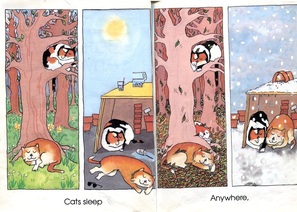
The back jacket flap in Jenkin's version has two nice paragraphs about Eleanor Farjeon. It tells us that she was born in London in 1881, a daughter of B.L. Farjeon, the novelist and a granddaughter of the famous American actor Joseph Jefferson. After mentioning a couple of her early works it goes on to say that Farjeon was "one of England's most distinguished writers for children....[she] received many awards during her long career. in 1956 the English Library Association awarded Eleanor Farjeon's The Little Bookroom the Carnegie Medal - given for the most distinguished book written by a British subject. For the body of her work, Miss Farjeon was the first author honored with the Hans Christian Andersen award, given by the International Board on Books for Young People...Miss Farjeon died in 1965 at the age of eighty-four."
The two short lines about Mary Price Jenkins mentions that she works and lives in Wales and that the cats on the jacket once shared a house with her.
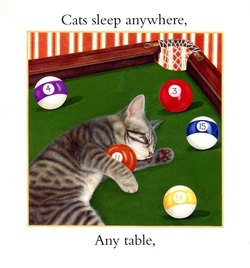
Contrast this with the biographical information about Farjeon from the Mortimer version which consists of two sentences, one which tells us that "she was typing stories, plays, and poems by the time she was seven." (emphasis mine)
Anne Mortimer's bio tells us about her line of greeting cards and stationery and that "her painting expertise has been recognized by the Royal Society of Miniature Painters, of which she is a memeber."
The difference in the bios in the two editions really say a lot about the nature of the two books. One is Farjeon's poem brought to life, the other is a cute collection of cat pictures decorated with a sweet little poem.
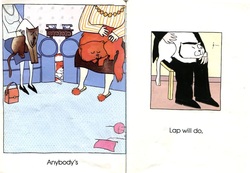
My favorite pictures in the Jenkins' version illustrate the line, "anybody's lap will do." Two ladies visit together over tea. The cats are quite comfortable in their laps. The lady on the right obviously lives in the house. She has slippers on. The lady on the right has a purse next to her feet and must be the visitor. I imagine that the lady of the house was knitting and one of the cats helpfully dragged her yarn out of the way and onto the floor.
There is a male visitor as well. He can be seen with a white cat on his lap. He doesn't mind the hairs that will be left on his black pants. If he did he'd have brushed the cat off of his lap by now. The white cat places it's little paw on the man's hand. Anyone who loves cats will recognize this gesture as one of comfort. Whether it's for the comfort of the cat or of the man, who knows? Who cares?
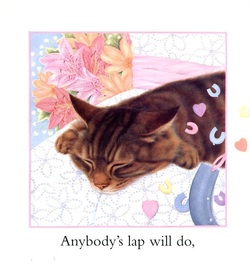
What a beautiful cat Mortimer has painted. We cat lovers recognize that sleepy look as well and can almost feel the warmth of a cat asleep on our lap. But in Mortimer's lovely painting, the person is barely discernible. It could be a chair or a pillow or a bed on which the cat is snoozing.
I must say that the cruder, more cartoonish illustrations of Mary Price Jenkins' book are much more successful than the flashy, gorgeous paintings of Mortimer's edition. Anne Mortimer has given us realism, but Jenkins has given us reality.




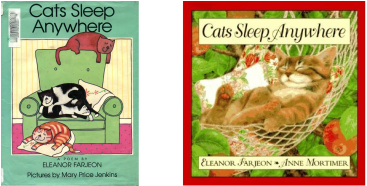
 RSS Feed
RSS Feed